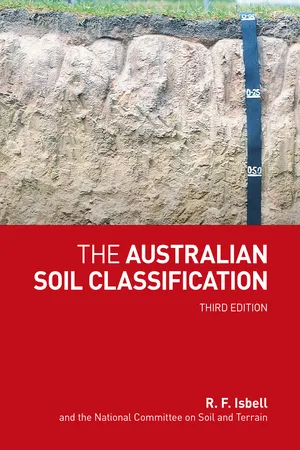
- 192 pages
- English
- ePUB (mobile friendly)
- Available on iOS & Android
The Australian Soil Classification
About this book
The Australian Soil Classification provides a framework for organising knowledge about Australian soils by allocating soils to classes via a key. Since its publication in 1996, this book has been widely adopted and formally endorsed as the official national system. It has provided a means of communication among scientists and land managers and has proven to be of particular value in land resource survey and research programs, environmental studies and education.
Classification is a basic requirement of all science and needs to be periodically revised as knowledge increases. This third edition of The Australian Soil Classification includes updates from a working group of the National Committee on Soil and Terrain (NCST). The main change in this edition accommodates new knowledge and understanding of the significance, nature, distribution and refined testing for soils comprising deep sands, leading to the inclusion of a new Order, the Arenosols. The introduction of the Arenosols Order led to a review and changes to Calcarosols, Tenosols and Rudosols.
The Australian Soil Classification is Volume 4 in the Australian Soil and Land Survey Handbooks Series.
We would like to acknowledge CSIRO Agriculture and Food for supporting the publication of this book and access to the eBook formats.
Frequently asked questions
- Essential is ideal for learners and professionals who enjoy exploring a wide range of subjects. Access the Essential Library with 800,000+ trusted titles and best-sellers across business, personal growth, and the humanities. Includes unlimited reading time and Standard Read Aloud voice.
- Complete: Perfect for advanced learners and researchers needing full, unrestricted access. Unlock 1.4M+ books across hundreds of subjects, including academic and specialized titles. The Complete Plan also includes advanced features like Premium Read Aloud and Research Assistant.
Please note we cannot support devices running on iOS 13 and Android 7 or earlier. Learn more about using the app.
Information
Table of contents
- Cover
- Title Page
- Copyright
- The authors
- Contents
- Acknowledgements
- Preface to the third edition
- Background
- How to classify
- Key to Soil Orders
- Anthroposols [AN]
- Arenosols [RE]
- Calcarosols [CA]
- Chromosols [CH]
- Dermosols [DE]
- Ferrosols [FE]
- Hydrosols [HY]
- Kandosols [KA]
- Kurosols [KU]
- Organosols [OR]
- Podosols [PO]
- Rudosols [RU]
- Sodosols [SO]
- Tenosols [TE]
- Vertosols [VE]
- Glossary
- Colour Classes
- References
- Appendix 1: Use of codes and confidence levels in recording classification of soil profiles
- Appendix 2: List of codes and equivalent class names
- Appendix 3: Class names and equivalent codes, and the level at which they occur in the Soil Orders
- Appendix 4: Analytical requirements for the Australian Soil Classification
- Appendix 5: Approximate correlations between the Australian Soil Classification Orders and other soil classifications
- Appendix 6: History of the development of the Australian Soil Classification
- Appendix 7: Summary of changes in the third edition